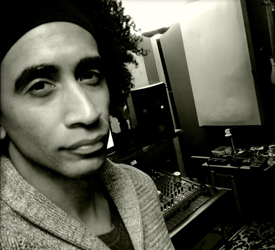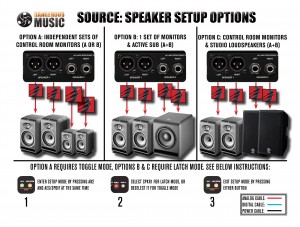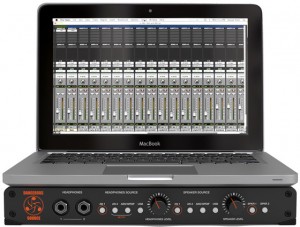Field Report: Dangerous Source in Action with Alan Evans of Soulive
There is nothing worse than having to question the quality of sound coming out of your studio monitors. Being able to hear exactly what you are recording and mixing is crucial, whether you’re getting paid or not.
I record and mix artists from all over the world at my studio in Western Massachusetts – everything from rock, bluegrass, and folk to funk and jazz. These are people who spend a lot of time and money on their craft and they are asking me to deliver them a final product that they are proud to play for people. It has to sound good!!
I was introduced to the Dangerous Source in the midst of some studio upgrades. I had recently brought an analog console into the picture, and after doing some monitoring chain comparisons, realized that I needed to make some changes: It seemed like the “printed” playback wasn’t always representing what I heard going in. Obviously that’s a problem, especially when you want to fix something in the mix – you need to be able to hear exactly how it’s going to come out! It was like I needed better monitors, only that’s not what I thought needed replacing.
This is where the Dangerous Source ($899) came in.
The Source is a high-end and portable monitoring system with monitor control for up to two pairs of speakers and headphones with digital, analog and USB sources. In my studio now, it sits at the end of my mix chain and ensures that my recorded mix in Digital Performer [my DAW] sounds the same as the mix on the console feeding the A-to-D converter recording the mix.
To explain how it fits into my rig, and how I came to realize that I needed it, I should back up a few steps.
TRACING THE SOURCE
Before getting the Dangerous Source, I was running the 2 mix out of my console into an external A-to-D converter, my Burl B2 ADC, then into my Metric Halo interface, which then fed my monitors (Mackie HR824’s and Auratones). Everything seemed fine with that until I hooked my monitors directly up to my console. There was immediately a depth and width to my mixes coming right off the console that using my interface as the monitor controller wasn’t giving me.
I pulled up a mix on the new board – a track I’d been mixing in-the-box for this really good soul-pop band out of Reno, The Mark Sexton Band – and wow! It sounded awesome and I was pretty psyched with the vibe, so I printed the mix back to my Digital Performer. But playing back from DP, the mix sounded nothing like it did straight off the console. It felt very one dimensional and lacking in excitement.
What was the point of recording and mixing on this console if I was going to be the only one to enjoy it?
As I continued to swap components in and out of the monitoring chain, I found I was getting markedly better results – but things had also gotten quite complicated. I realized I wanted to find something that was dedicated to monitoring, and analog and digital inputs were a must.
Enter the Dangerous Source.
FEATURES & FUNCTIONALITY
The Dangerous Source is a great little unit with big functionality that can be used in many different ways, as both a studio and mobile monitoring controller.
- Studio Monitor Controller:
The Source has two analog speaker outputs to connect two sets of monitors. You can also use the speaker 2 output to feed a subwoofer because the Source can be programed either for one speaker at a time for A-B style listening, or for enabling speaker 2 to turn on at the same time as speaker 1. The front facing switches allow quick and silent switching between Speaker 1 and Speaker 2 outputs.
The headphone amp in the Source sounds great and the two headphone outputs are really handy especially when tracking with someone else in the room. You can send separate, independent mixes to the headphones and to the control room speakers, and the headphone Cue mix can come from any of the four input sources connected to the Source.
- Mobile Monitor Controller:
The Source is just as functional in a mobile situation as it would be in the studio – so its size is what’s most notable here. Sharing the same footprint as a 13” MacBook and weighing less than 7lbs this is the perfect unit for location tracking/mixing. It’s great for the user who needs to have studio-quality monitoring while they’re away from their studio – i.e. a DJ or producer, or mixer working out of a hotel room.
The user manual for the Source is short and thorough. After taking ten minutes to read about all of its features, I felt confident enough to wire it up and roll. And that’s exactly what happened.
Right now I have two sets of monitors connected (one passive using a power amp, and one active) and I’m using the AES input. The line outputs on my Source will be used at some point for a two-track tape machine, since the selected line outs mirror the control room selection and can be used as ‘recording’ or ‘dubbing’ outputs which are independent of the volume control – one more way to keep my options open as my studio evolves.
Finally, the two DACs (digital to analog converters) in the Source are the most noticeable (and yet invisible) feature – and the fact that there are two independent D/A converters built into this unit is incredible. This allows you to monitor two different digital input sources at once, one feeding the headphones and a different digital output feeding the speakers. For example, USB to the Cue mix in the headphones and AES into the control room speakers. Having 2 DACs also allows you to layer 2 digital sources over each other, either for monitoring or for recording using the above-mentioned Selected Line Outs.
The noticeable part is that whatever your material, the Source reveals it to you through your monitors or headphones with stunning clarity. I have not heard a device (at least nothing that wasn’t a permanent fixture in a million dollar studio) better at converting 0’s and 1’s into beautiful sounding audio.
The invisible part is that the converters are of such a high quality, you don’t even know they are there. No more distracting digital artifacts or unwanted noise – just audio, pure and simple. Brilliant!
LIKE GETTING A NEW SET OF MONITORS
Back to my studio upgrade, and the difference the Source made in my setup, I was told by my friends at Audio Power Tools that getting the Dangerous Source would be like getting a new set of monitors. This description is 100% correct: With the Source as my D-to-A, I’m hearing my mixes EXACTLY the way they came off the console, and because of the variety of inputs and routing possibilities I can monitor before or after my recording A-to-D converter.
The low end is tight and punchy. The mids and highs are extremely detailed and musical. The stereo separation is incredible. I find myself using less EQ in mixes using the Dangerous Source, which is great – less is more – and I’m finding it very easy to place every element of the song in the mix. Every voice is felt and heard, and when I A/B my printed mixes to the mixes playing right off the console – there is no difference. So I know that the client is getting exactly what they have paid for.
Additionally, when I connected my turntable directly to the Source’s analog input, I was again blown away by the fidelity of this unit. I was hearing so much detail in albums I grew up listening to and on albums I recorded and mixed – both the speaker and headphone outputs sound amazing.
So far, my Source has not left the studio but I’m really looking forward to taking it out soon. And that’s the other cool thing about it: no matter what other kinds of upgrades I throw into my studio, the Source will always be there… because it’s small so I can take it on the road if need be, so I’ll always know whatever I’m hearing, wherever I am – in my own studio or someone else’s – what I’m hearing is what it is…good or bad.
I have only two gripes with the Source: The first is the lack of a mono switch, as I like to go back and forth from stereo to mono while mixing. But with that said, the high quality and fidelity of this unit has made me nearly forget this and I can always find a workaround.
The second issue is that this thing sounds so good, I want to go back and re-mix years of music…. hahaha!
IN CONCLUSION
So – at $899 – is the Source really worth it? I’ve been making money recording and mixing for over 20 years now. Over those 20 years I’ve wasted a good amount of money on gear that was trendy, quirky or just plain old cheap. Most of the time I was just trying to save a buck and get something that was “close” to the real thing.
The Dangerous Source is made to perform at top levels in a world-class multi-million dollar studio or in your bedroom studio. If your prized possessions right now are a couple of 57’s, your laptop, an open-source DAW and some headphones, right on!! I’m with you and I’m all about it. But I would suggest you strongly consider the Source when your budget allows it.
We are all putting a lot of time, energy and love into our music. Make sure you and everyone else who hears your music can really appreciate your vision.
Dangerous Source
Street Price: $899
Click for more information!
Alan Evans is a producer/engineer and co-founder/drummer of the bands Soulive and The Alan Evans Trio.
Please note: When you buy products through links on this page, we may earn an affiliate commission.











Zach McNees
April 4, 2013 at 1:37 pm (12 years ago)Looks killer. Great review!